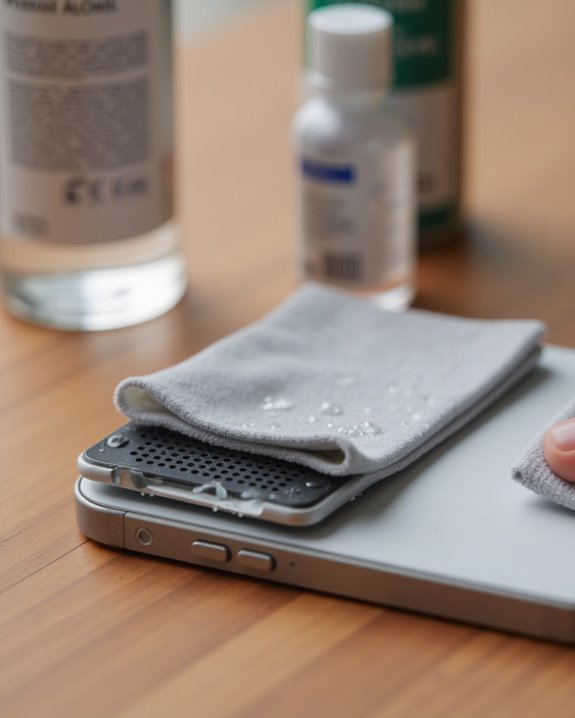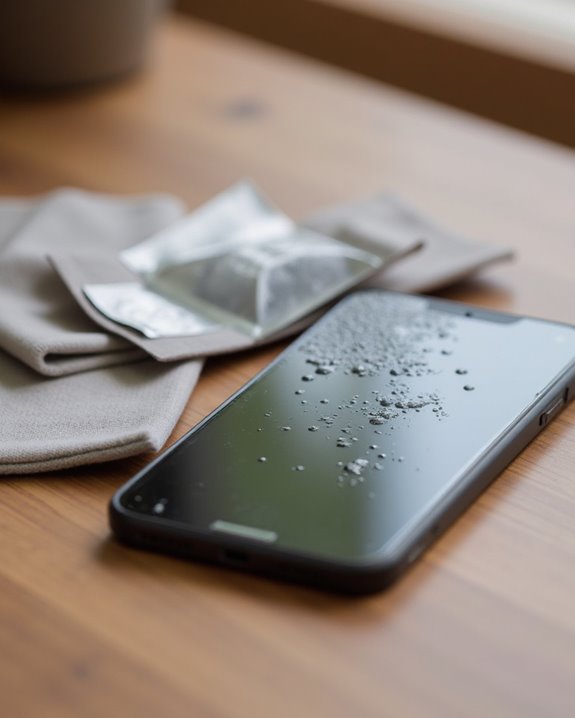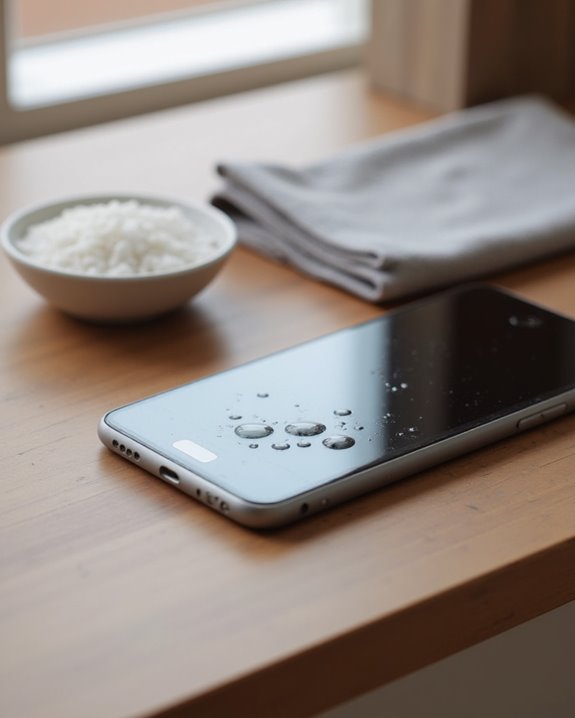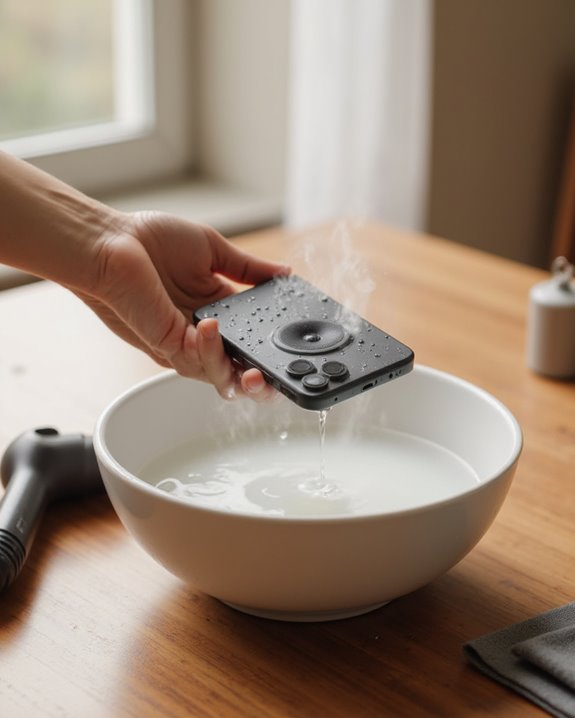To remove water from a phone speaker, first power off the device and shake it with speaker facing downward. Wipe the exterior with a microfiber cloth, then use sound wave apps (20-200 Hz) at maximum volume to vibrate water out. Try gentle vacuum suction for stubborn moisture or place the phone at a slight downward incline. For thorough drying, seal the phone with silica gel packets for 24-48 hours. These methods effectively extract moisture without compromising internal components.
Key Takeaways
- Power down your phone immediately to prevent short circuits and shake gently with speakers facing downward to remove excess water.
- Use a clean microfiber cloth to dry the phone’s exterior thoroughly, focusing on accessible areas around speaker grilles.
- Play low-frequency sounds (20-200 Hz) at maximum volume with speakers facing downward to vibrate water out.
- Create a slight incline with the speaker at the lowest point to allow natural drainage onto an absorbent cloth.
- Place phone in a sealed container with silica gel packets for 24-48 hours before powering on to ensure complete drying.
Turn Off Your Phone and Shake Out Excess Water
Powering down a water-exposed phone immediately serves as the critical first line of defense against potential damage. Water conducts electricity, which can create short circuits in the device’s internal components, potentially causing permanent damage to the phone speaker and other vital parts. Phone manufacturers typically void warranties for water damage, making this precautionary step essential.
After powering off, users should hold the phone with the speaker facing downward and gently shake to eject excess moisture. This technique uses gravity to remove water from the speaker grilles and ports. Following the initial shake, experts recommend lightly tapping the phone while maintaining the downward position to dislodge any remaining water droplets. This controlled method helps prevent moisture from penetrating deeper into the device, creating ideal conditions for subsequent drying procedures. For devices exposed to salt water, rinse with fresh water to help preserve the device’s seals and prevent further damage.
Wipe and Dry the Exterior With a Microfiber Cloth
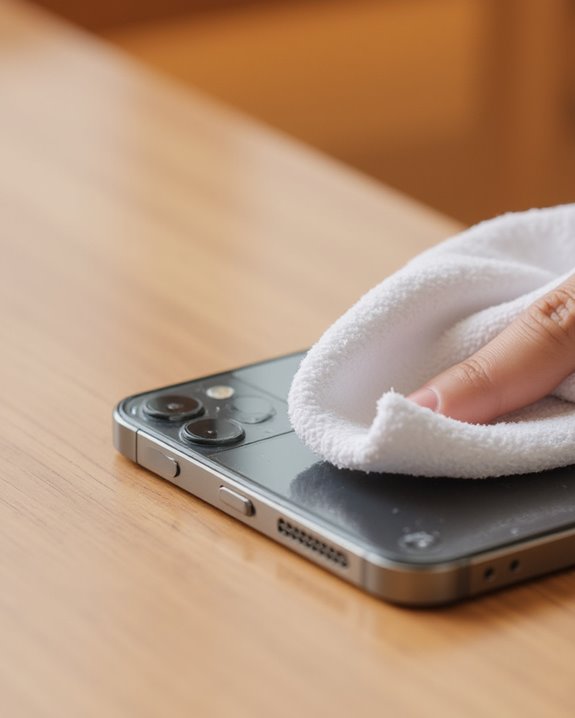
Thoroughly dry the phone’s exterior using a clean microfiber cloth immediately after shaking out excess water, as this gentle material effectively absorbs moisture without scratching delicate surfaces. The lint-free microfiber cloth specifically removes visible water while preventing additional fibers from entering ports or crevices, which could worsen the situation. Users should methodically wipe the entire device, including the screen, back panel, and sides, ensuring all water droplets are absorbed from accessible areas.
This critical step helps prevent moisture from penetrating deeper into the phone’s speaker and other internal components. After thoroughly cleaning the exterior, gently tap the device with ports facing downward to dislodge remaining water droplets. The soft cloth to clean approach, when performed promptly, greatly improves the likelihood of getting your phone dry without permanent damage. To further safeguard your device against future water exposure, consider iPhone-compatible accessories that boast IPX7 rating for enhanced durability.
Use Sound Waves to Eject Water From Speakers
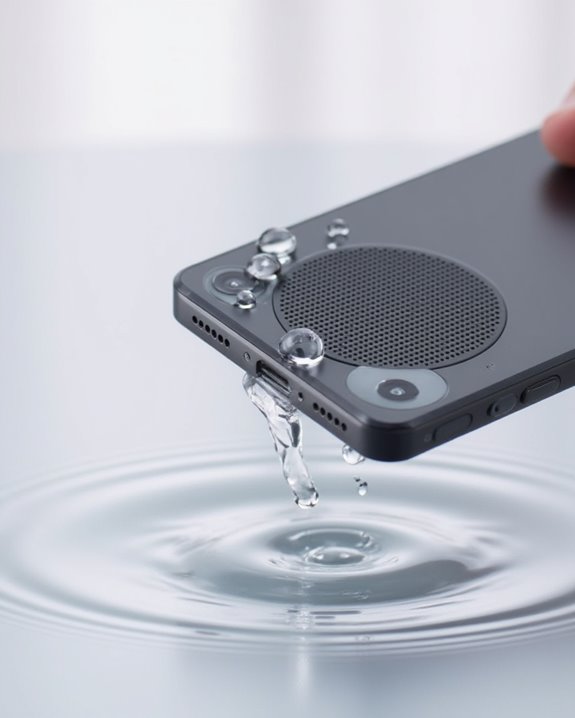
Leverage sound waves to force water out of your phone’s speaker by using specialized websites or apps designed to emit specific frequencies that create vibrations. Websites like fixmyspeakers.com or apps such as Sonic for iPhone and Water Eject shortcut for Android generate low-frequency sounds between 20-200 Hz that effectively push water out of speaker meshes. These sound waves create physical vibrations that dislodge trapped moisture without damaging internal components.
To maximize effectiveness, set the phone’s volume to maximum, position the device with speakers facing downward on a slight incline, and play the frequency wave for 10-15 seconds per session. Users should limit each cycle to 2-3 repetitions, allowing breaks between sessions. Alternatively, playing songs with prominent low frequencies, such as “Miroh” by Stray Kids, can similarly eject water from phone speakers. For better results in wet environments, you might also use a IPX7 waterproof Bluetooth speaker to generate these frequencies safely.
Try the Vacuum Method for Water Extraction
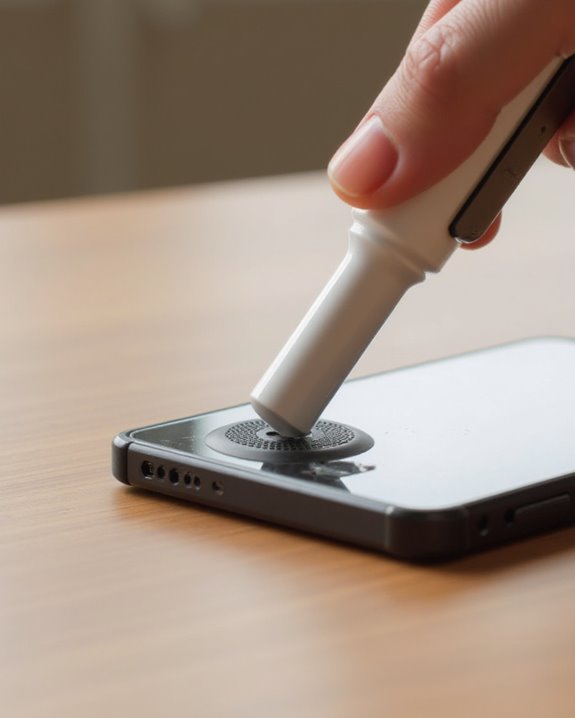
When dealing with water-damaged speakers, the vacuum method offers a physical approach to extract moisture from your phone’s components. Before attempting this technique, users should power off their phone completely to prevent electrical damage while working to remove water inside the device.
A vacuum cleaner with a small nozzle attachment, such as a car vacuum or standard household model on low suction setting, works effectively for this purpose. The nozzle should be cleaned beforehand to prevent introducing contaminants into the phone’s speakers. When ready, position the vacuum directly over the speaker grills and apply gentle suction for 10-15 seconds per area, targeting spots where water might be trapped. This targeted approach helps draw out moisture from difficult-to-reach areas, allowing the phone to dry more thoroughly and potentially restore normal audio function.
Position Your Phone for Optimal Drainage
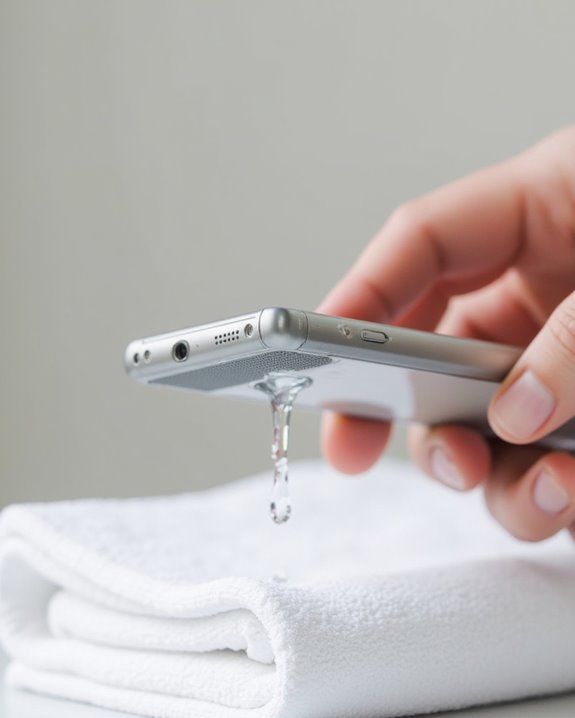
Proper positioning of your phone creates an ideal environment for water drainage from speaker cavities. When water infiltrates a device’s speaker, gravity becomes a powerful ally in the extraction process. Users should place their phone on a flat surface with the speaker facing downward, allowing water droplets to naturally flow away from sensitive components. For situations with significant moisture, creating a slight incline with the speaker at the lowest point helps direct water away more efficiently.
Take your phone and put it on a soft cloth while maintaining this drainage position, as the fabric will absorb emerging moisture while protecting the device’s exterior. Avoid positioning the phone upright or sideways, as these orientations impede natural water flow. Make sure nothing covers the speaker opening, as obstructions can trap moisture and prevent proper airflow necessary for complete drying.
Utilize Desiccants for Thorough Drying
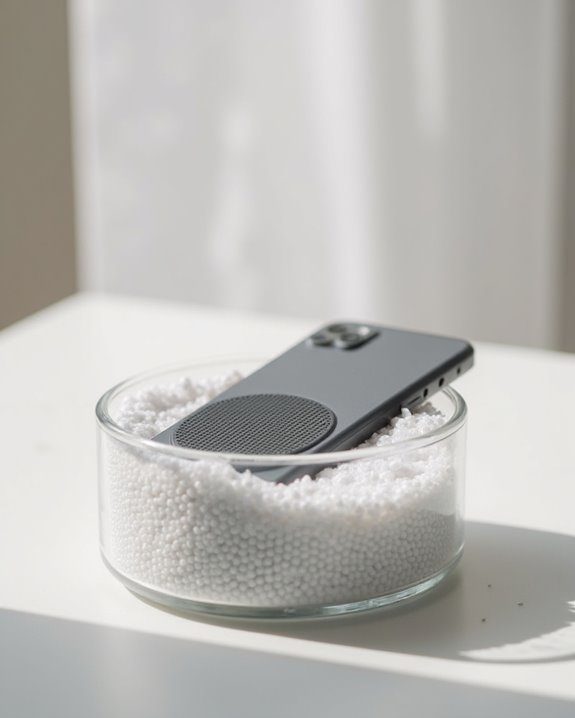
While positioning your phone correctly encourages water drainage, desiccants offer a more thorough solution for extracting moisture from speaker components. After water exposure, immediately power off the device and place it in a sealed bag of silica gel packets for 24-48 hours. Silica gel efficiently absorbs water droplets from internal components, preventing severe damage to sensitive circuitry.
For those without silica gel, crystal kitty litter serves as an effective alternative, using 4 cups in a sealed container to draw out as much water as possible. Though some recommend placing a phone in rice, this method extracts only 10-15% of moisture compared to silica gel’s superior absorption. After treatment, wait the full 48 hours before powering on to guarantee all moisture has been removed, protecting speakers from dust and water damage during the critical drying period.
Test Your Speaker and Consider Professional Help
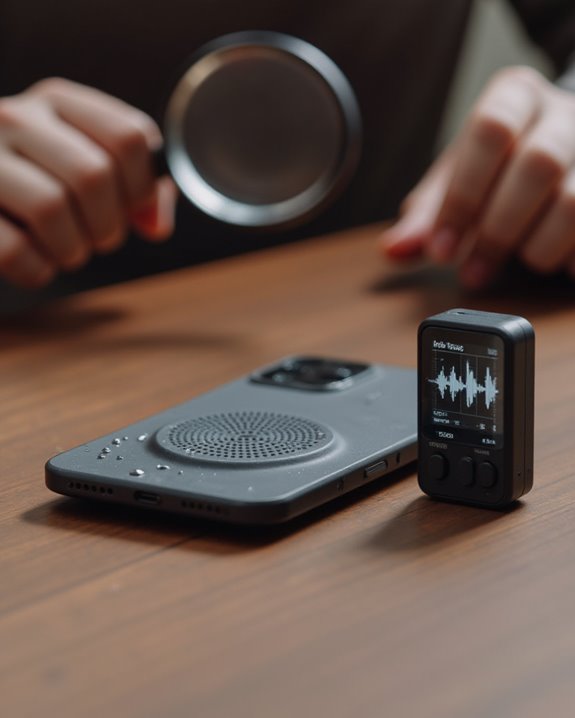
After completing all drying methods and waiting the recommended 5-6 hours, users should thoroughly test their phone’s speaker functionality to determine if water damage persists. Play the sound at maximum volume, listening carefully for any muffled sound or distortion that might indicate water remains inside the speaker. If audio is hard to hear or sounds crackly despite using special sound frequencies to help push water out, additional intervention may be necessary.
Users can revisit the Fix My Speakers website to Begin Water Ejection process again or tap the button several more times. However, if problems continue beyond 24-48 hours after initial water exposure, professional assistance is recommended. The speaker’s recovery chances decrease greatly with extended moisture exposure, making timely assessment essential for preventing permanent damage that DIY methods cannot address.
Frequently Asked Questions
How to Get Water Out From Phone Speaker?
Speaker Maintenance Tips include using sound test procedures to vibrate water out. Desiccant absorption methods with silica gel packets effectively remove moisture. Prevention strategies now emphasize powering off devices immediately and utilizing low-powered vacuums to extract water from phone speakers.
What Is the Easiest Way to Get Water Out of Your Phone?
Experts recommend specialized sound frequencies to vibrate water from phone speakers. While desiccant packs may help damaged phones, the rice myth persists despite ineffectiveness. Professional repair options provide alternatives when prevention tips and simple drying techniques fail.
How to Get Water Out of a Waterproof Speaker?
In the battle of a lifetime against moisture, waterproof speaker maintenance involves turning off devices immediately, employing audio dehumidifying through low-frequency sounds, drainage methods by tapping downward, and desiccant use with silica gel for effective submersion recovery.
How Do I Clear My Speaker?
Effective speaker maintenance requires addressing any sound obstruction through gentle debris clearing. Dust removal using microfiber cloths, low-powered vacuums, or sound wave techniques can eliminate audio clogs, reducing static and boosting volume without professional repair.

